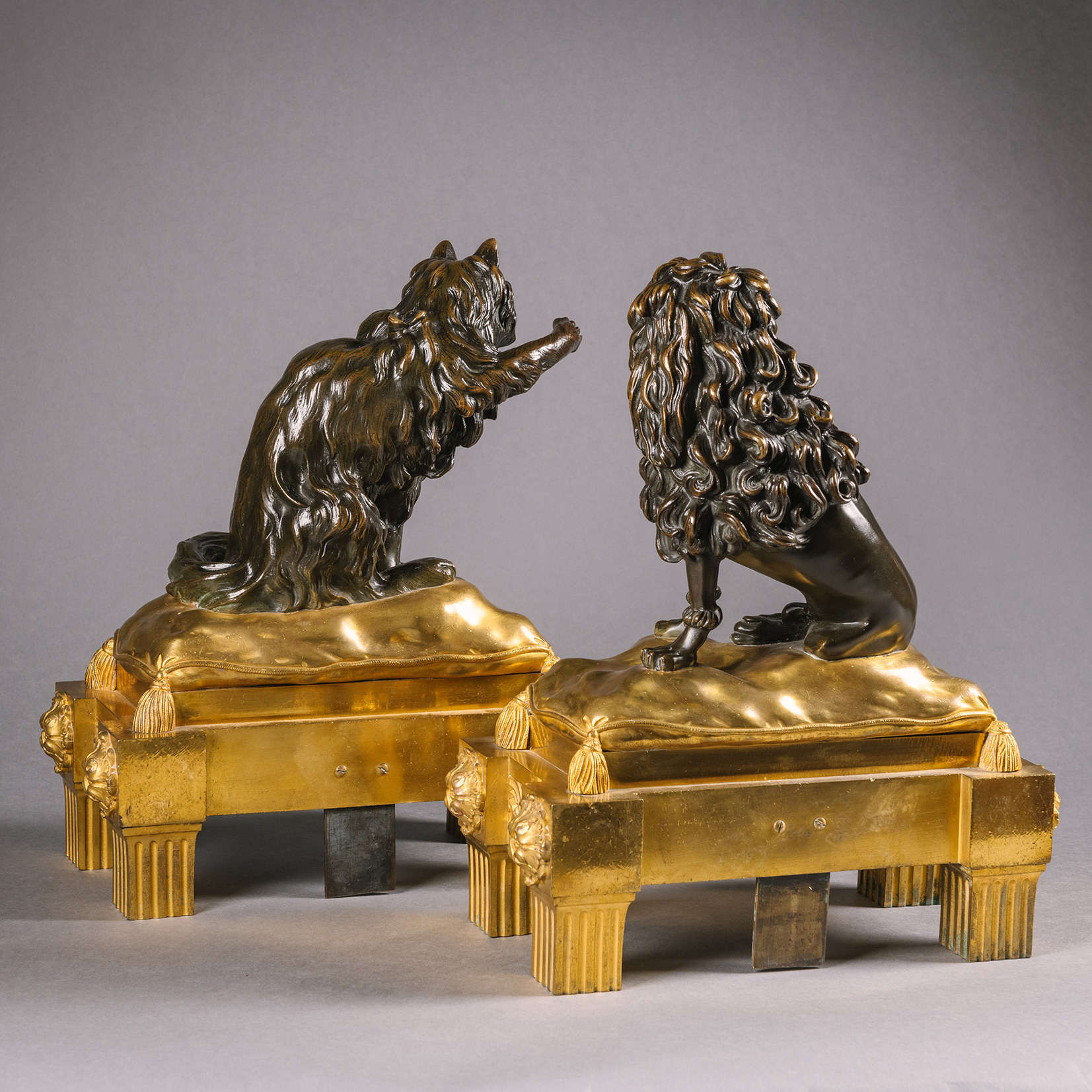After Jacques Caffieri
A Pair Of Late Louis XV Period Figural Chenets
£18,000
A Pair Of Late Louis XV Period Gilt And Patinated Bronze Figural Chenets, Attributed to Jacques and Philippe Caffieri. Modelled as a dog and cat, each...
Dimensions
Height: 35 cm (14 in)Width: 30 cm (12 in)
Depth: 17 cm (7 in)
Description
A Pair Of Late Louis XV Period Gilt And Patinated Bronze Figural Chenets, Attributed to Jacques and Philippe Caffieri.
Modelled as a dog and cat, each seated on a tasselled cushion atop a Goût grec base with entrelac panelled frieze and eared corners with rosette paterae. On tapering fluted square tapering feet.
French, Circa 1770.The sculptural design of these chenets, modelled with figures of a poodle and a Persian cat is characteristic of the playful inventiveness of the high rococo, whilst the goût grec bases are indicative of changing tastes during the late Louis XV period towards neoclassicism.
The model was first recorded in a 1755 inventory taken from Jacques Caffieri’s workshop and his son Philippe Caffieri supplied a pair of chenets featuring a cat and dog, probably of the same model to the present lot, to the Prince de Condé in 1773, at a cost of 1,120 livres (S. Eriksen, Early Neo-Classicism in France, London, 1974, p. 357 pl. 223).
The models of a dog and cat are recorded on varying bases, here with tasselled cushion and handsome neoclassical entrelac and rosette cast bases, are the earliest known variant. Example with this base Sotheby’s, Monaco, 21-22 May 1978, lot 76 and Sotheby’s, Monaco, 11 February 1979, lot 234a (as illustrated in H. Ottomeyer and P. Proschel,Vergoldete Bronzen, vol. 1, Munich, 1986, p.201).
Date
Circa 1770
Origin
France
Medium
Gilt & Patinated Bronze
Jacques Caffieri (1678-1755) a sculptor famous for his works in bronze, was the son of Philippe Caffieri (1634-1716), who emigrated from Naples to Paris at the request of Cardinal Mazarin to decorate the interiors at Versailles. He was elected to the Académie de Saint-Luc as a sculptor, and thus created many of the original designs that were proprietary models of his foundry.
Jacques was received as a maître fondeur-ciseleur by 1715, the date of his first known work, a design for a pall for the Corporation des Fondeurs-Ciseleurs, one of the two Parisian guilds that oversaw works cast in metal.
Caffieri was appointed fondeur-ciseleur des Bâtiments du Roi in 1736. Following this, a large proportion of his best work as a designer and chaser in bronze was executed for commissions to the crown at Versailles, Fontainebleau, Marly, Compiègne, Choisy and the Château de La Muette. In fact, he executed so much work for the crown that they were forever in his debt, still owing him money at his death.
In addition to these royal commissions from his workshop in rue des Canettes came an amazing amount of work, chiefly in the shape of gilt-bronze furniture mounts used by the best ébénistes of Paris, with whom he worked closely. Little of his production was ordinary and an astonishingly large proportion of it is now famous. Caffieri was also known for his production of gilt-bronze cases for clocks.
In 1740, Caffieri’s wife purchased a royal privilege, which allowed the Caffieri workshop to gild bronze as well as cast it within the same workshop; ordinarily the processes were divided between two Parisian corporations, jealous of their jurisdictions, the fondeurs-ciseleurs and the ciseleurs-doreurs. This privilege further set Caffieri apart from his rivals.
Bibliography:
Ottomeyer, Hans & Proschel, Peter. Vergoldete Bronzen, Vol I, Klinkhardt & Biermann, (Munich), 1986; p 137, pl. 2.10.3.
Verlet, Pierre. Les Bronzes Dorés Français du XVIIIe siècle, (France), 1987; p. 288, pl. 324.
Sotheby’s, Monaco, 23-24 June 1976, lot 146.













 Print
Print


